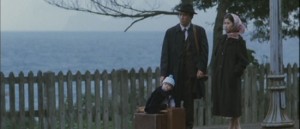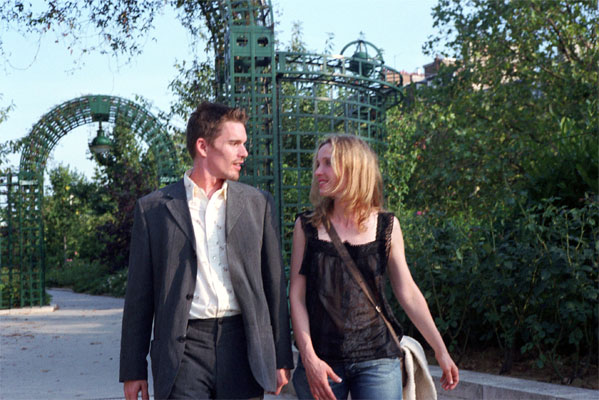This capsule review for the Chicago Reader is a way of mourning the untimely death of Berenice Reynaud, whose lovely book about the film offers a good sampling of her brilliant insights.

This remarkable and beautiful 160-minute family saga by the great Taiwanese filmmaker Hou Hsiao-hsien (Goodbye South, Goodbye, Flowers of Shanghai) begins in 1945, when Japan ended its 51-year colonial rule in Taiwan, and concludes in 1949, when mainland China became communist and Chiang Kai-shek’s government retreated to Taipei. Perceiving these historical upheavals through the varied lives of a single family, Hou again proves himself a master of long takes and complex framing, with a great talent for passionate (though elliptical and distanced) storytelling. Given the diverse languages and dialects spoken here (including the language of a deaf-mute, rendered in intertitles), this 1989 drama is largely a meditation on communication itself, and appropriately enough it was the first Taiwanese film to use direct sound. It’s also one of the supreme masterworks of the contemporary cinema and, as the first feature of Hou’s magisterial trilogy about Taiwan during the 20th century (followed in 1993 by The Puppetmaster and in 1995 by Good Men, Good Women), an excellent launch to the Film Center’s eight-film Hou retrospective, which runs over the next three weeks. Read more
From The Soho News (October 29, 1980). — J.R.

What attracted me to sign up in advance for a symposium called “Television/Society/Art,” put on at the Kitchen and NYU last weekend, was the opportunity to see and hear some old friends, encounter some new people, and maybe even get some new ideas (about what I should be reading and seeing, if nothing else): a bargain for the $10 registration fee.
Presented by the Kitchen and the American Film Institute and organized by Ron Clark, a senior instructor at the Whitney Museum’s Independent Study Program, the three-day event inevitably threatened a few dead spots — particularly to a virtual videophobe like me, who largely regards the medium as a kind of wicker basket holding a few magazines that I’m neither interested in reading nor quite ready to throw away. On the other hand, the fact that some of the invited panelists seemed to share the same bias made me suspect that I’d feel right at home.
The symposium got off to a somewhat inauspicious start with the presentation of a lumbering keynote paper entitled “Television Images, Codes and Messages” by Douglas Kellner, a teacher of philosophy at the University of Texas’s Austin campus. Read more
From the Chicago Reader (July 2, 2004). — J.R.

Before Sunset
**** (Masterpiece)
Directed by Richard Linklater
Written by Linklater, Kim Krizan, Julie Delpy, and Ethan Hawke
With Delpy and Hawke.
“The years shall run like rabbits,
For in my arms I hold
The Flower of the Ages,
And the first love of the world.”
But all the clocks in the city
Began to whirr and chime:
“O let not Time deceive you,
You cannot conquer Time….
“O plunge your hands in water,
Plunge them in up to the wrist;
Stare, stare in the basin
And wonder what you’ve missed.”
— from W.H. Auden’s “As I Walked Out One Evening” (1937)
Richard Linklater, like Wong Kar-wai on the opposite side of the globe, is a lyrical and elegiac filmmaker. In many of his films, as in many of Wong’s, the subject is time — the romance and poetry of moments ticking by, the wonder and anguish of living through and then remembering an hour or a day.
Future generations may look back at Linklater and Wong as poets laureate of the turn of the century who excelled at catching the tenor of their times. In Days of Being Wild and Slacker, Ashes of Time and The Newton Boys, Happy Together and Dazed and Confused, and In the Mood for Love and Before Sunrise they’re especially astute observers of where and who we are in history. Read more
To celebrate the release of Kino Lorber’s excellent DVD and Blu-Ray of Sternberg’s still-controversial and often misrepresented masterpiece, with many first-rate extras (and including both the 1953 and 1958 versions of the film), I’m posting this again. It first appeared in the January-February 1978 issue of Film Comment, with a few tweaks added in June 2010. I’ve also included, at the very end of this piece, a photograph of the real-life survivors of Anatahan that I found on the Internet. And to clarify the mimetic form of this piece, which has nine sections corresponding to the nine sections of Sternberg’s film, I’ve numbered each of those sections, for the first time.
This was written while I was teaching film at the University of California, San Diego and was able to study a 16-millimeter print of Anatahan that I was using in a course. This article was reprinted in my first collection, Placing Movies: The Practice of Film Criticism (Berkeley: University of California Press, 1995), where I added the following: “One of the critical commonplaces about THE SAGA OF ANATAHAN is that everything in the film with the exception of the ocean waves is artificial and created, and Sternberg has often been uncritically quoted as saying that the only thing he regretted in the film were these waves, precisely because they were not of his making. Read more



